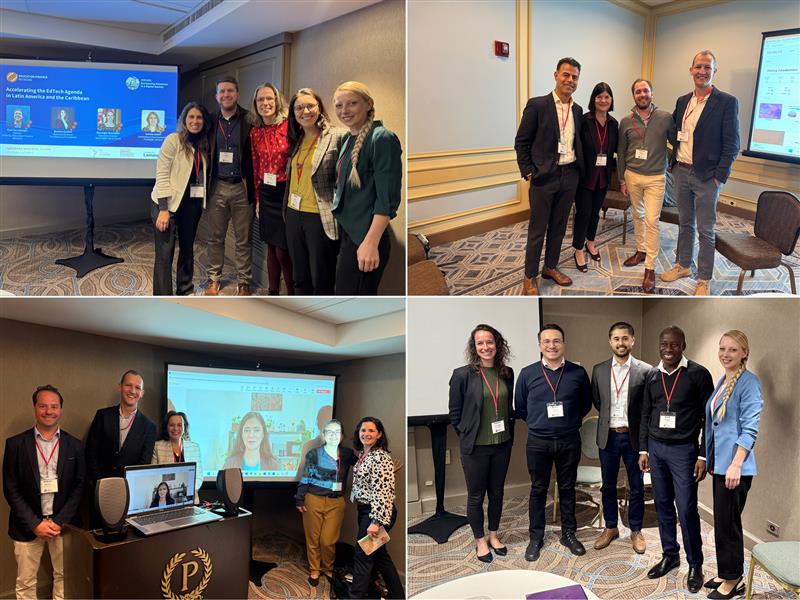Dalberg uses cookies and related technologies to improve the way the site functions. A cookie is a text file that is stored on your device. We use these text files for functionality such as to analyze our traffic or to personalize content. You can easily control how we use cookies on your device by adjusting the settings below, and you may also change those settings at any time by visiting our privacy policy page.
Originally published by the Education Finance Network, this blog is republished here as part of Dalberg’s ongoing collaboration to advance innovative and inclusive education financing.

At the CIES 2025 Conference, the Education Finance Network (EFN) was honored to host four dynamic panels with its members. Over the five days, we discussed the shifting contours of global education, from early childhood financing and artificial intelligence to educational data systems and regional EdTech innovation. While each panel tackled a distinct theme, shared priorities and recurring principles came into focus. Regardless of the tool, model, or context, achieving meaningful transformation in education depends on more than new ideas—it requires targeted investment, inclusive design, and continuous collaboration. This blog draws out key cross-cutting insights for funders, practitioners, and policymakers, with the aim of informing how we finance and scale solutions for learners worldwide.
Start with People: Human-Centered Systems First
Though the panels explored themes such as technology and innovative financing, the most consistent insight was deeply human: sustainable education change begins by centering the lived realities of teachers, students, parents, and communities. Smart investment isn’t just about deploying the latest innovation—it’s about funding tools that are designed with and for the people who use them, and ensuring the right support is in place to help them succeed.
In Brazil, for example, Nova Escola reached over 800,000 teachers by designing lesson-planning tools tailored to the everyday needs of educators working in isolation—delivered not through custom platforms, but through WhatsApp. In Ghana, district officials tested user-informed data dashboards to ensure school-level information was actionable and aligned with local decision-making needs. As noted by Arjun Upadhyay from EdTech Hub in the From Data to Decisions session, a shift in mindset is needed—from data collection for compliance to data as a tool for learning. Once that shift begins, technology supports more responsive, learning-driven approaches to decision-making.
In Vietnam, the development of AI-powered learning tools highlighted another essential insight: trust-building is critical to adoption, especially in contexts where parents may be unfamiliar with education technology. Before students could benefit, developers had to first educate and engage parents, underscoring that effective innovation must extend beyond the classroom. This user-centric lens also reinforces the need for financing models that prioritize not just scale, but relevance and relationship-building, a space where EFN supports collaboration between funders, implementers, and the broader education ecosystem, grounded in alignment with public systems.
Across all EFN panels, the message was clear: co-design with users isn’t optional—it’s foundational.
Innovation with Inclusion: Equity as a Design Principle
Equity isn’t just an outcome—it must be a starting point. Across the CIES EFN panels, it became clear that inclusive education innovation requires intentionality at every stage, from design to delivery to financing. Inclusion must span both digital access and community realities.
At the individual level, barriers to digital access remain significant. While smartphone usage continues to grow, nearly 31% of the global population still lacks connectivity. As Vicki Phillips from the National Center on Education and the Economy (NCEE) emphasized during the AI in Education session, “We need to make sure that we go that last distance.” Panelists pointed to strategies like blended finance models, partnerships with mobile providers, and the use of low-tech platforms to help close this gap—especially in underserved or rural areas.
But inclusion also means recognizing and responding to local contexts. In one example, shared during the From Data to Decisions discussion, schools adjusted the scheduling of remedial classes to accommodate student absences during harvest season. This kind of community-driven adaptation demonstrates how small shifts, grounded in local insight, can have meaningful impact.
At the system level, financing models must also be examined through an equity lens. In early childhood care, smaller centers serving low-income communities often lack access to credit, as lenders tend to favor larger, fee-based institutions. Without targeted support, these centers risk being left out of broader quality improvement efforts. As Andrew McCusker from Opportunity International EduFinance shared in the Investing in Early Learning panel, this is a critical blind spot in many current financing mechanisms.
Across all panels, the message was consistent: equity requires deliberate design—not just in technology, but in financing, delivery, and everyday decision-making.
Finance is Not Enough, But It’s Essential
A key insight from the early childhood financing panel was that funding alone is not a silver bullet. While access to capital is necessary for expanding services, its impact on quality depends on how it’s used. Research—including findings from The University of Chicago’s work on school improvement—has shown that investments in leadership development, technical assistance, quality assurance, and enabling environments are critical drivers of learning outcomes. Without these “wraparound” supports, financing may struggle to translate into meaningful educational gains.
But innovative finance models still matter. Whether through results-based financing in South Africa, philanthropic risk-taking in EdTech pilots, or mobile-based deployment of AI tools in underserved regions, strategic investment can unlock equity and scale. It must, however, be paired with non-financial enablers.
Measurement and Accountability: Learning What Works (and What Doesn’t)
Measurement emerged as a recurring challenge across panels, particularly the need for tools that are both contextually appropriate and trusted by stakeholders. From early childhood outcomes to AI-driven learning tools, panelists highlighted that the success of education innovations often hinges on the ability to measure impact in meaningful and credible ways.
Countries like South Africa and Rwanda are adapting international early childhood development (ECD) quality frameworks to fit national contexts, while Uruguay’s CEIBAL initiative offers a promising model—serving as a public hub for evaluating and scaling EdTech tools based on rigorous assessment as described by Beatriz Guillen, from The Resource Foundation. In other cases, like school dropout tracking, data is being used to inform community-led action, with parent-teacher associations engaging directly in interpreting and responding to local patterns.
Done well, measurement builds trust and fuels iteration. But when poorly designed or overly complex, it can overwhelm systems and erode confidence among educators and decision-makers.
Working with Government to Scale
At South Africa’s 2024 ECD summit, the government committed to piloting results-based financing for early childhood care and education. As Özsel Beleli from the Education Outcomes Fund (EOF) noted during the panel, this marked a concrete step toward integrating innovation into public financing—showing how strategic government engagement can unlock national-level scale.
Across all EFN panels, the message was consistent: public systems are critical levers for scale. In Latin America, panelists emphasized that a significant majority of students—often over 80% in many countries—attend public schools. Even in countries with active private sectors, public education systems remain central to shaping policy, allocating funding, and ensuring nationwide reach. Simply put, bypassing the government isn’t a viable strategy for lasting impact.
That said, collaboration must be thoughtful and strategic. In Colombia, a previous initiative to implement performance-based education models yielded mixed results—offering valuable lessons about the need to align innovations with existing system capacities, stakeholder buy-in, and the broader policy environment. Successful approaches often focus on piloting contextually relevant solutions, building evidence through early results, and identifying internal champions who can help scale and embed reforms.
The takeaway? Scaling innovation in education requires strong alignment with public policy environments and a clear understanding of how to work with—and alongside—government systems.
Turning Insight into Actions
Across four panels, a shared message stood out: change doesn’t scale through innovation alone. It takes capital, context, and collaboration. It’s time to move from promising pilots to scalable solutions, where investments in AI, EdTech, and early learning finance deliver lasting impact.
This is the mission at the heart of EFN: to bridge the gap between innovation and impact through smart financing and grounded partnerships. By fostering collaboration between non-state actors and public education systems, EFN is accelerating progress toward inclusive, scalable education solutions in LMICs.
Early momentum—reflected in strong engagement and growing awareness across the network—signals the foundation for lasting change: greater access to quality education and improved learning outcomes for disadvantaged learners.
The path ahead is clear: invest boldly, collaborate widely, and scale what works.
Panel Contributors
The 69th CIES conference took place from 22–26 March 2025 in Chicago, US.
With sincere thanks to all the panelists, this blog draws on the thoughtful insights and rich discussions shared across the four CIES EFN 2025 panels, featuring contributions from:
- Accelerating the EdTech Agenda in Latin America and the Caribbean, with Kusi Hornberger, Dalberg, and the Education Finance Network; Beatriz Guillen, The Resource Foundation; Ana Ligia Scachetti, Nova Escola Association; and Camila Anker, Fundação Lemann
- AI in Education: Evidence, Trends, and Market Insights, with Charlie Habershon, Dalberg, and the Education Finance Network; Vicki Phillips, National Center on Education and the Economy (NCEE); Francisco Carballo, Rising Academies; and Sandeep Aneja, Kaizenvest
- Investing in Early Learning: Exploring Innovative Financing in Early Childhood Care and Education, with Charlie Habershon, Dalberg, and the Education Finance Network; Elizabeth Lule, the Early Childhood Development Action Network (ECDAN); Arushi Terway, NORRAG – the Global Education Centre of the Geneva Graduate Institute; Özsel Beleli, The Education Outcomes Fund (EOF); Lauren Pisani; and Andrew McCusker, Opportunity International EduFinance
- From Data to Decisions: Empowering Schools and Policy Makers Through Digital Information Systems, with Saskia Sickinger, Dalberg and the Education Finance Network; Arjun Upadhyay, EdTech Hub; Amosi Chipasi and David Boateng, Promoting Equality in African Schools (PEAS); Steph Dobrowolski, Rising Academies; and Rafael Andres Arias Albañil, Fundación Corona
To know more, contact:


